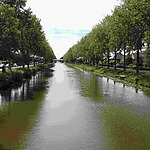Since the draining, the reclamation has played an important role in the Dutch society, with probably the most important part being Schiphol Airport at approximately 4.5 meters below sea level.
The draining of the Haarlemmermeer (18,100 hectares) was one of the first, and certainly at that time the largest State project of this kind. The draining also played an important role in the introduction of steam power pumping.
In the Haarlemmermeer, peat excavation and storms regularly caused the banks to erode, causing the lake to grow from 9,100 hectares since 1250 to 16,850 hectares in 1848.
Since 1617 many plans had been submitted and designs made for the draining of the Haarlemmermeer. With the exception of the last plan, none of the plans was approved for realization. The first known plan for draining was probably made during or shortly after 1615 by Gerbrant Meussz. Only a map is known and no text. This map was used in 1617 by Anthonius de Hoog et al. when filing a patent application for draining of the Haarlemmermeer.
In 1629 Jan Adriaensz. Leeghwater (1575-1650) came up with his first plan for draining the Haarlemmermeer. In 1635 he came up with an adjusted plan in which he stated that he started from the map of Meussz., with an improvement here and there. In 1640 he published an almost identical edition of his plan. The accompanying map shows 160 windmills with paddle wheels, placed in 40 series of 4 windmills.
The best-known plan was published by Leeghwater in his Haerlemmer-Meer-Boeck, the first edition of which appeared in 1641. No less than thirteen other editions of this book were subsequently published, with occasional adjustments. The 13th edition of the Haerlemmer-Meer-Boeck was published almost two hundred years later in 1838 by Van Hasselt. He included an extensive introduction and also provided a historical overview of the various plans for draining the Haarlemmermeer. In 2009, Aten et al. published an edited version of the 4th edition of the Haerlemmer-Meer-Boeck, with an extensive explanation. In addition to Leeghwater's plans, there have been many other plans. In more or less chronological order, the following plans can be mentioned, among others: Gerrit Meerman, Elias Trip, Jacob Bartelsz. de Veeris, Pieter Louis Daunis, Jan Noppen with Melchior Bolstra and Nicolaas Samuelsz. Cruquius, Conrad Zumbach de Koesvelt, Arie Jansz. Blanken and Frans Godert Baron van Lynden van Hemmen.
The many discussions between proponents and opponents of the draining have also led to the necessary research, mainly to show that the draining would yield many advantages. For example, under the supervision of the mayor of Aalsmeer, Leeghwater conducted research into the quality of the soil of the Haarlemmermeer, about which he reported in the Haerlemmer-Meer-Boeck:
"Concerning the soil of the Haerlemmer-meer, I cannot find or understand otherwise if everything is good, even though I have previously sounded, drilled, dredged, deepened, felt and thoroughly examined it with the Mayors of Aelsmeer and many other workers in many different places, and otherwise I cannot find or observe whether the same lake has a bottom of good clay, generally thick seven, eight and nine feet, as has been reported."
The decision to drain the Haarlemmermeer was finally taken after two storms had caused flooding. The first on 29 November 1836, when 4,000 hectares in the direction of Amsterdam were flooded, and the second on 26 December 1836, when 7,500 hectares in the direction of Leiden were flooded.
Before the actual draining of the Haarlemmermeer started, extensive discussions took place on how this should be done. Steam engines had been in use for a long time before they were used for draining of polders in the Netherlands. In order to arrive at a decision on how the Haarlemmermeer should be drained, a State Commission was appointed on 7 August 1837 with the task of drawing up a plan and budget for the draining of the Haarlemmermeer.
This Commission came with its advice for the draining with: 1) 32 series of two windmills with Archimedes screws; 2) 5 series of three windmills with inclined paddle wheels; 3) three steam power pumping stations with screws, at Halfweg, Spaarndam and at the Kaag respectively. Adjustments were also advised with regard to the transport and collecting system of Rijnland, of which the most important were: a fourth discharge sluice at Halfweg, improvement of the discharge at Katwijk, local deepening of the Spaarne and, if necessary, construction of a steam power pumping station and a fifth discharge sluice at Spaarndam. The act to come to the draining of the Haarlemmermeer on the basis of this advice was rejected on 2 April 1838.
Following this, King William I appointed a new Commission, consisting of three experts, who he knew were in favour of steam power pumping. This Commission was given the task of advising on whether or not the draining should preferably be realised by steam power pumping stations and whether the use of peat would be advisable in that case. Again, there were the necessary discussions. On 4 December 1838 Gerrit Simons submitted to this Commission a plan for draining of the Haarlemmermeer with three steam power pumping stations: Cruquius, Leeghwater and Lijnden. Shortly thereafter, on 22 March 1839, the Act was passed on the basis of which the Haarlemmermeer was drained between 1848 and 1852.
The Haarlemmermeer Polder has since changed from an agricultural polder to an increasingly urbanized polder, including Schiphol Airport and many houses and buildings. Over the years, the water management and flood protection systems have been adjusted to the desired level.




